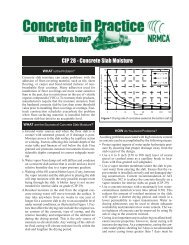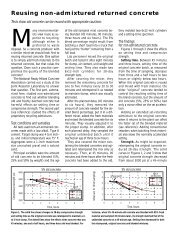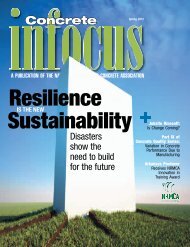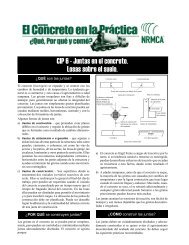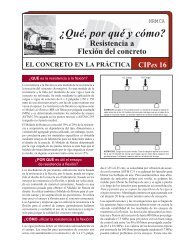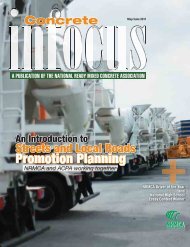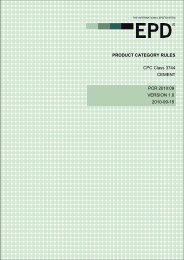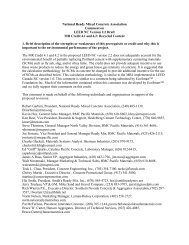Fall 2004 - National Ready Mixed Concrete Association
Fall 2004 - National Ready Mixed Concrete Association
Fall 2004 - National Ready Mixed Concrete Association
You also want an ePaper? Increase the reach of your titles
YUMPU automatically turns print PDFs into web optimized ePapers that Google loves.
tech talk<br />
one LEED point is earned for using a light<br />
colored pavement, such as concrete, for 30%<br />
of a site’s paved surfaces. Using pervious<br />
concrete pavement to reduce stormwater<br />
runoff can earn one LEED point. Using<br />
energy efficient wall systems, such as tilt-up<br />
concrete walls or insulating concrete forms,<br />
can contribute to gaining LEED points.<br />
<strong>Concrete</strong> contributes to available LEED<br />
points by using regionally manufactured<br />
materials—concrete is made within a 500-<br />
mile radius of a building site and most of the<br />
materials are also harvested within 500 miles<br />
of the site.<br />
<strong>Concrete</strong> also contributes to LEED<br />
points available for using recycled products.<br />
The requirement is to use materials with<br />
recycled content such that the sum of the<br />
post-consumer recycled content plus onehalf<br />
of the post-industrial recycled content<br />
totals 5% for 1 point or 10% for 2 points.<br />
The calculation is based on value or cost of<br />
materials. The value of the recycled content<br />
portion of a material is determined by<br />
dividing the weight of recycled content in<br />
the item by the total weight of all materials<br />
in the item, then multiplying the resulting<br />
percentage by the total value of the item.<br />
Supplementary cementitious materials<br />
(SCMs) such as fly ash, slag and silica fume<br />
are considered post-industrial recycled content.<br />
Example: Assume a project is built using<br />
tilt-up concrete walls, slab-on-grade, concrete<br />
footings and a concrete parking area.<br />
The total project cost is $5 million and the<br />
total cost of materials is $2.25 million. The<br />
total amount of concrete used on the project<br />
is 1,850 cubic yards at a cost of $70 per<br />
cubic yard. The mix design calls for 225<br />
pounds of fly ash per cubic yard. The recycled<br />
content rate is calculated as follows: (at<br />
right)<br />
To obtain one LEED point for this project,<br />
recycled content rates for all other items<br />
must total 4.84% or more to achieve the 5%<br />
minimum requirement. Other strategies for<br />
increasing recycled content in concrete<br />
include using flowable fill that contains high<br />
volumes of fly ash, using recycled aggregate<br />
*post-industrial recycled content is given 1/2<br />
credit.<br />
Fly Ash for <strong>Concrete</strong> Products<br />
Delivering performance<br />
when performance counts.<br />
Every time.<br />
Quality. Reliability. Service.<br />
ISG Resources is the nation’s leading<br />
supplier of fly ash to the concrete<br />
industry. Operating coast to coast,<br />
ISG provides more than material – we<br />
provide unparalleled customer service<br />
and technical support to ensure you<br />
get results.<br />
From ready mixed to precast.<br />
Highways, structures, flowable fills.<br />
Your product will perform better with<br />
fly ash.<br />
Performance Building Materials from<br />
Coal Combustion Products<br />
For information, call John Ward at 888-236-6236<br />
www.flyash.com<br />
32 ı FALL <strong>2004</strong>



